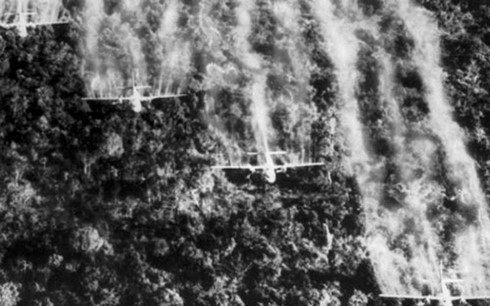(VOVworld) – In war time, the Vietnamese government ordered the army and the public health care system to provide treatments to those who were exposed to toxic chemicals. When Vietnam was unified in April 1975, the State adopted policies for victims of Agent Orange/dioxin and mobilized resources to help them in production, health care, education, and rehabilitation.
 |
From 1961 to 1971, the US army sprayed nearly 80 million litters of toxic chemical on southern Vietnam (Photo: Archive)
|
300,000 war veterans and their offspring affected by Agent Orange/dioxin have been recognized as policy beneficiaries. 30% of the victims are provided with health insurance and 25% of affected children are rehabilitated.
Dr. Hoang Manh An, Director of Military Hospital 103, said his organization was one of the first to help Agent Orange/dioxin victims. An says he and his colleagues use traditional remedies, which are much cheaper than the Hubbard detoxification method, which costs each patient about 700 USD. “We have been conducting a 4-week traditional detox program and the results are similar to the Hubbard method. This is a boon to the victims because it costs only one third as much as the Hubbard method. We believe our method boosts health of Agent Orange/dioxin victims”.
AO/dioxin-affected kids are also provided with education. Nguyen Van Cuong, manager of a center which brings up children suffering from Agent Orange/dioxin in Lam Dong province, said: “In the 3 years of operation, our center gas brought up more than 40 kids. Some of them graduated and returned to their family. Some moved to other places to live and the rests were given job at the center. There are now 13 mentally disabled kids and we teach them how to read and write so they can integrate into the community.”
Le Quoc Bao, Chairman of the Tien Giang Association for Victims of Agent Orange/Dioxin, said: “We classify the victims so that they will be given the most appropriate care. We provide scholarships, jobs, and financing to help victims improve their lives by raising cows, or goats, or conducting household businesses. Young victims are given vocational training. We have coordinated with the Overseas Vietnamese Association in France and with other sectors to take care of them.”
Since the Vietnam Association for Victims of Agent Orange/Dioxin was established in 2004, it has opened branches to 63 cities and provinces. Its members now number 360,000. Over the past 5 years, the Association raised some 50 million USD to meet the victims’ basic needs. Rehabilitation centers have been built, 500 victims given vocational training, 1,600 houses repaired, and 78,000 patients given free medicines. Nguyen Thi Hien, Chairwoman of he Da Nang Association for Victims of Agent Orange/Dioxin, said she feels most happy when bringing happiness to the victims: “I call my Association a taxi, meaning it ‘s available whenever there’s a call. We don’t have Sunday off, because we feel we should go to meet those in need. The happiness of an Association official is being able to help ease the pain of the victims.”